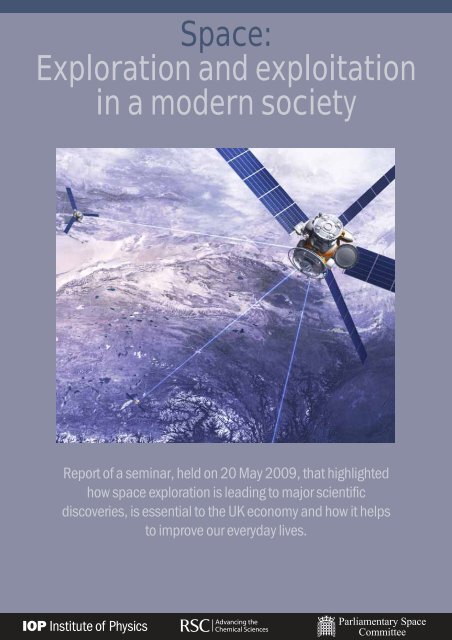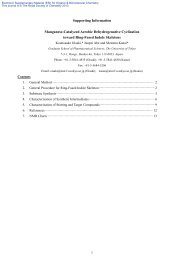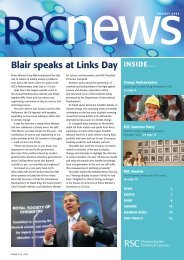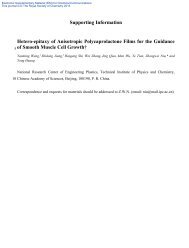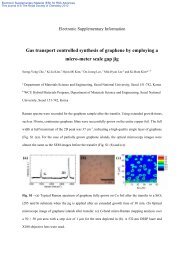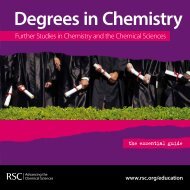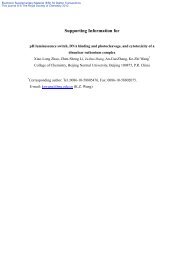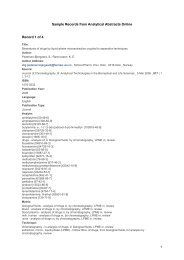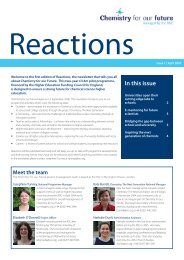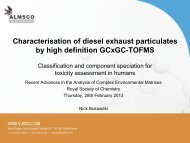Space: Exploration and exploitation in a modern society
Space: Exploration and exploitation in a modern society
Space: Exploration and exploitation in a modern society
Create successful ePaper yourself
Turn your PDF publications into a flip-book with our unique Google optimized e-Paper software.
<strong>Space</strong>:<br />
<strong>Exploration</strong> <strong>and</strong> <strong>exploitation</strong><br />
<strong>in</strong> a <strong>modern</strong> <strong>society</strong><br />
Report of a sem<strong>in</strong>ar, held on 20 May 2009, that highlighted<br />
how space exploration is lead<strong>in</strong>g to major scientific<br />
discoveries, is essential to the UK economy <strong>and</strong> how it helps<br />
to improve our everyday lives.
<strong>Space</strong>: <strong>Exploration</strong> <strong>and</strong> <strong>exploitation</strong> <strong>in</strong> a <strong>modern</strong> <strong>society</strong><br />
Introduction<br />
The Institute of Physics, the Royal Society of Chemistry <strong>and</strong> the Parliamentary <strong>Space</strong> Committee<br />
held a jo<strong>in</strong>t sem<strong>in</strong>ar at the House of Commons on 20 May 2009. The sem<strong>in</strong>ar highlighted how space<br />
exploration is lead<strong>in</strong>g to major scientific discoveries, is essential to the UK economy <strong>and</strong> how it helps<br />
to improve our everyday lives while play<strong>in</strong>g a crucial role <strong>in</strong> manag<strong>in</strong>g global challenges such as<br />
climate change.<br />
Curiosity about the Earth, the planets <strong>and</strong> stars has been the driv<strong>in</strong>g force beh<strong>in</strong>d human progress<br />
s<strong>in</strong>ce prehistoric times. Today, the exploration of the universe beyond the conf<strong>in</strong>es of our home<br />
planet rema<strong>in</strong>s one of the most <strong>in</strong>spir<strong>in</strong>g, excit<strong>in</strong>g <strong>and</strong> fruitful areas of scientific research. Many<br />
studies require send<strong>in</strong>g spacecraft <strong>in</strong>to space, mostly unmanned, although humans first reached the<br />
Moon 40 years ago <strong>and</strong> may go to Mars <strong>in</strong> the future. One of the ma<strong>in</strong> advantages of <strong>in</strong>vestigat<strong>in</strong>g<br />
the universe from space is that the details of far-off galaxies, as well as events mark<strong>in</strong>g the birth,<br />
evolution <strong>and</strong> death of stars, can be seen unhampered by the blurr<strong>in</strong>g effects of the atmosphere, <strong>and</strong><br />
at wavelengths of light not easily accessible from the ground. Increas<strong>in</strong>gly, scientists <strong>and</strong> eng<strong>in</strong>eers<br />
are develop<strong>in</strong>g advanced space probes, with robotic components that can operate autonomously, to<br />
explore the extraord<strong>in</strong>arily diverse planets <strong>and</strong> moons of our solar system.<br />
As well as gaz<strong>in</strong>g at the cosmos, many space missions are designed to look back at the Earth, to study<br />
its rich complexity <strong>and</strong> the effects of humans on the terrestrial environment. Satellite services is one<br />
of the fastest-grow<strong>in</strong>g areas of advanced technology. It is now hard to imag<strong>in</strong>e <strong>modern</strong> life without<br />
satellite communications – for enterta<strong>in</strong>ment, <strong>in</strong>formation, security <strong>and</strong> environmental monitor<strong>in</strong>g.<br />
Basic science, Earth observation <strong>and</strong> the application of technology <strong>in</strong> everyday life cont<strong>in</strong>ue to benefit<br />
hugely from space exploration. As governments <strong>and</strong> space agencies plan ever more technically<br />
challeng<strong>in</strong>g missions to survey the universe, go<strong>in</strong>g back to its birth, <strong>and</strong> even to search for signs of life<br />
on planets around other stars, the result<strong>in</strong>g technologies developed will f<strong>in</strong>d use on Earth, <strong>in</strong> sectors as<br />
diverse as health <strong>and</strong> transport. One day we may even be able to utilise the natural resources, such as<br />
water <strong>and</strong> fuels, that are found on other solar-system bodies, as our own supplies dw<strong>in</strong>dle.<br />
Mr Ian Taylor MP, co-chairman of the Parliamentary <strong>Space</strong> Committee <strong>and</strong> a former m<strong>in</strong>ister for<br />
science <strong>and</strong> technology, chaired the sem<strong>in</strong>ar. He emphasised that space projects <strong>in</strong>spire everyone<br />
<strong>and</strong> draw young people <strong>in</strong>to study<strong>in</strong>g science. He po<strong>in</strong>ted out that satellite services are play<strong>in</strong>g an<br />
<strong>in</strong>creas<strong>in</strong>gly important part <strong>in</strong> monitor<strong>in</strong>g l<strong>and</strong> use, transport services <strong>and</strong> the impact of environmental<br />
disasters. Prof. David Southwood, director of science <strong>and</strong> robotic exploration at the European <strong>Space</strong><br />
Agency (ESA), expla<strong>in</strong>ed how current <strong>and</strong> future space-science missions will cont<strong>in</strong>ue to transform our<br />
underst<strong>and</strong><strong>in</strong>g of basic physics <strong>and</strong> the universe, as well as the Earth itself. Mr David Williams, chief<br />
executive of the satellite-communications company Avanti Communications, described how space<br />
science <strong>and</strong> technology are generat<strong>in</strong>g flourish<strong>in</strong>g <strong>and</strong> exp<strong>and</strong><strong>in</strong>g space-based <strong>in</strong>dustries <strong>and</strong> services<br />
<strong>in</strong> the UK. Dr Maggie Ader<strong>in</strong>-Pocock, optical <strong>in</strong>strumentation group leader of the European aerospace<br />
company Astrium <strong>and</strong> STFC-funded fellow of University College London, gave examples of how recent<br />
space missions are impact<strong>in</strong>g on our lives <strong>and</strong> exp<strong>and</strong><strong>in</strong>g our perception of our place <strong>in</strong> the universe.<br />
The UK has a major space programme, which it pursues through membership of ESA <strong>and</strong> some bilateral<br />
collaborations outside Europe. Eighteen European countries participate <strong>in</strong> ESA, <strong>and</strong> the number is<br />
likely to grow with <strong>in</strong>creas<strong>in</strong>g <strong>in</strong>terest from eastern Europe. ESA’s remit covers the exploration of<br />
the universe, Earth observation, <strong>and</strong> the development of underp<strong>in</strong>n<strong>in</strong>g technology for commercial<br />
satellite operations <strong>and</strong> other applications. Although ESA’s budget is smaller than that of NASA, its<br />
programmes are highly productive, both <strong>in</strong> terms of the scientific discoveries <strong>and</strong> economic benefits<br />
derived from novel technologies developed to carry them out.<br />
S p a c e : Ex p l o r a t i o n a n d e x p l o i t a t i o n <strong>in</strong> a m o d e r n s o c i e t y August 2 0 0 9<br />
1
<strong>Space</strong>: <strong>Exploration</strong> <strong>and</strong> <strong>exploitation</strong> <strong>in</strong> a <strong>modern</strong> <strong>society</strong><br />
<strong>Space</strong> discovery <strong>and</strong> exploration<br />
Prof. Southwood said that look<strong>in</strong>g out <strong>in</strong>to<br />
space at the Sun <strong>and</strong> stars <strong>and</strong> measur<strong>in</strong>g their<br />
progression has been a key part of human<br />
progress for thous<strong>and</strong>s of years. He described<br />
how reach<strong>in</strong>g out <strong>in</strong>to space dur<strong>in</strong>g the past<br />
50 years has exp<strong>and</strong>ed our knowledge of the<br />
universe <strong>in</strong> an extraord<strong>in</strong>ary way. <strong>Space</strong> missions<br />
enabled galaxies, stars <strong>and</strong> <strong>in</strong>terstellar space to<br />
be observed at wavelengths of electromagnetic<br />
radiation not possible from the ground,<br />
provid<strong>in</strong>g new <strong>in</strong>sights <strong>in</strong>to astrophysical<br />
processes. For example, observations of the sky<br />
around the familiar constellation of Orion at<br />
<strong>in</strong>frared wavelengths (which are absorbed by<br />
atmospheric water) reveal vast clouds of cold,<br />
glow<strong>in</strong>g dust, which is condens<strong>in</strong>g <strong>in</strong>to new<br />
stars <strong>and</strong> planetary systems. Our own solar<br />
system is constructed from the same build<strong>in</strong>g<br />
blocks. “We are made of the same stardust,” said<br />
Prof. Southwood.<br />
ESA has launched a gamut of space-science<br />
missions that make observations at wavelengths<br />
cover<strong>in</strong>g most of the electromagnetic spectrum,<br />
from gamma rays to microwaves. X-ray astronomy<br />
provides details of the most violent events <strong>in</strong><br />
the universe, such as those associated with black<br />
holes, while ESA’s most recent missions – Herschel<br />
<strong>and</strong> Planck, which were launched together <strong>in</strong><br />
May 2009 – are survey<strong>in</strong>g the universe at cool<br />
<strong>in</strong>frared <strong>and</strong> microwave wavelengths. Herschel<br />
boasts the biggest telescope ever launched. It is<br />
cryogenically cooled <strong>and</strong> holds the record for the<br />
coldest object <strong>in</strong> space, at 0.05º above absolute<br />
zero. Designed to detect radiation from cold,<br />
distant parts of the universe, Herschel can peer<br />
at young galaxies that formed only a billion years<br />
after the Big Bang. The Planck mission looks back<br />
even further, at the pervasive longer microwave<br />
radiation left over from the decoupl<strong>in</strong>g of matter<br />
<strong>and</strong> light 380 000 years after the Big Bang. The<br />
microwave background carries impr<strong>in</strong>ts of the<br />
primordial quantum events that set <strong>in</strong> motion the<br />
formation of the first galactic structures. Both<br />
missions are named after scientists who made<br />
fundamental discoveries that affect our lives.<br />
Sir William Herschel, work<strong>in</strong>g <strong>in</strong> Bath, was the<br />
first scientist to identify <strong>in</strong>frared radiation, while<br />
the German physicist Max Planck showed that<br />
radiation came <strong>in</strong> packets of energy called quanta.<br />
Both discoveries are vital to the way that we live<br />
<strong>modern</strong> life.<br />
Prof. Southwood expla<strong>in</strong>ed that ESA has an<br />
extremely successful programme of solar-system<br />
exploration. It <strong>in</strong>cludes missions to study the Sun,<br />
Moon, Venus, Mars, Jupiter <strong>and</strong> Saturn, as well<br />
as to l<strong>and</strong> on a comet. The missions cont<strong>in</strong>ue to<br />
produce fasc<strong>in</strong>at<strong>in</strong>g <strong>and</strong> unexpected data that<br />
provide <strong>in</strong>sights <strong>in</strong>to the Earth’s own geology<br />
<strong>and</strong> meteorology, <strong>and</strong> provide clues on how life<br />
evolved. ESA plans to send a mission to Mercury<br />
<strong>in</strong> 2013. “It has been a wonderful decade of<br />
discovery for ESA,” said Prof. Southwood.<br />
Many of ESA’s missions are carried out <strong>in</strong><br />
partnership with NASA. The most celebrated<br />
is the Hubble <strong>Space</strong> Telescope, which has been<br />
send<strong>in</strong>g back spectacular images of the universe<br />
for nearly 20 years. Global collaboration will<br />
<strong>in</strong>creas<strong>in</strong>gly be needed for the most ambitious<br />
projects. “We are try<strong>in</strong>g to forge a jo<strong>in</strong>t<br />
European/US programme for the exploration of<br />
the Red Planet [Mars],” said Prof. Southwood.<br />
ESA <strong>and</strong> NASA recently proposed the creation of<br />
the Mars <strong>Exploration</strong> Jo<strong>in</strong>t Initiative (MEJI), which<br />
will provide a framework for the two agencies<br />
to def<strong>in</strong>e <strong>and</strong> implement their scientific <strong>and</strong><br />
technological programmes. The UK plans to play<br />
an active role <strong>in</strong> such missions. Prof. Southwood<br />
said that the UK’s bid to l<strong>and</strong> a robotic explorer<br />
Beagle 2 on Mars <strong>in</strong> 2003 had changed British<br />
people’s perceptions of space, <strong>and</strong> had re<strong>in</strong>forced<br />
the UK’s capabilities <strong>in</strong> robotic exploration. As a<br />
consequence, a new ESA facility will be set up on<br />
the Harwell Science <strong>and</strong> Innovation Campus <strong>in</strong><br />
Oxfordshire, to concentrate on space robotics <strong>and</strong><br />
climate-change science.<br />
The launch of the<br />
Planck <strong>and</strong> Herschel<br />
missions. Courtesy:<br />
European <strong>Space</strong><br />
Agency/D Ducros/<br />
Science Photo Library<br />
S p a c e : Ex p l o r a t i o n a n d e x p l o i t a t i o n <strong>in</strong> a m o d e r n s o c i e t y August 2 0 0 9<br />
2
<strong>Space</strong>: <strong>Exploration</strong> <strong>and</strong> <strong>exploitation</strong> <strong>in</strong> a <strong>modern</strong> <strong>society</strong><br />
Economic impact of fund<strong>in</strong>g space research<br />
Avanti<br />
Communications’<br />
share-price<br />
performance<br />
illustrat<strong>in</strong>g how<br />
growth of the UK<br />
space <strong>in</strong>dustry<br />
consistently<br />
outstrips broader<br />
economic growth.<br />
Courtesy: Avanti<br />
Communications<br />
260<br />
240<br />
220<br />
200<br />
180<br />
160<br />
Avanti Communications Group Plc<br />
UK FTSE All-Share (Rebased)<br />
FTSE AIM All-Share Index (Rebased)<br />
140<br />
120<br />
100<br />
80<br />
2008<br />
Jun<br />
Jul Aug Sep Oct Nov Dec Jan<br />
2009<br />
Feb<br />
Mar Apr May<br />
<strong>Space</strong>-science discoveries <strong>and</strong> technology<br />
development will cont<strong>in</strong>ue to go h<strong>and</strong> <strong>in</strong> h<strong>and</strong>.<br />
This was the message from Mr Williams. His<br />
company Avanti Communications was founded on<br />
basic research <strong>and</strong> applied science, he said. It is the<br />
first European company to launch a satellite-based<br />
super-fast broadb<strong>and</strong> service serv<strong>in</strong>g customers<br />
<strong>in</strong> rural areas. The underp<strong>in</strong>n<strong>in</strong>g technology<br />
stems from ESA’s Advanced Research <strong>in</strong><br />
Telecommunications Systems (ARTES) programme,<br />
which enables European <strong>in</strong>dustry to explore<br />
new ideas for satellite-communications products<br />
<strong>and</strong> services. The new broadb<strong>and</strong> service will<br />
contribute towards the implementation of the<br />
government’s “Digital Brita<strong>in</strong>” policy to secure<br />
the UK’s position as one of the world’s lead<strong>in</strong>g<br />
digital-knowledge economies.<br />
Mr Williams po<strong>in</strong>ted out that the UK holds a<br />
dom<strong>in</strong>ant position <strong>in</strong> the space <strong>in</strong>dustry because<br />
it has built up a critical mass of knowledge<br />
<strong>and</strong> human resources over a long period that<br />
makes it difficult for others to compete. “The<br />
UK has a very lean <strong>and</strong> focused attitude towards<br />
space, concentrat<strong>in</strong>g on cutt<strong>in</strong>g-edge payloads,<br />
<strong>in</strong>strumentation <strong>and</strong> small platforms. The result<br />
is that we have generated a seven-fold return on<br />
<strong>in</strong>vestment from the ARTES budget,” he said.<br />
Some of the world’s most successful space<br />
companies are based <strong>in</strong> the UK, support<strong>in</strong>g<br />
70 000 jobs <strong>and</strong> a highly skilled workforce. As well<br />
as Avanti Communications, they <strong>in</strong>clude: Europe’s<br />
lead<strong>in</strong>g space company Astrium; Infoterra,<br />
which is a leader <strong>in</strong> Earth-observation services;<br />
Inmarsat, which is the world’s most profitable<br />
telecommunications company; Paradigm, which<br />
provides military satellite-communications<br />
services; <strong>and</strong> Surrey Satellite Telecommunications,<br />
which pioneered low-cost satellites. Downstream<br />
<strong>in</strong>dustries such as Sky TV have also flourished.<br />
“We should be very proud of our <strong>in</strong>dustry,” said<br />
Mr Williams.<br />
Accord<strong>in</strong>g to the lead<strong>in</strong>g economic forecast<strong>in</strong>g<br />
consultancy, Oxford Economics, the global space<br />
<strong>in</strong>dustry is set to grow by 15% a year. However,<br />
Mr Williams warned that the UK must ma<strong>in</strong>ta<strong>in</strong><br />
its momentum of develop<strong>in</strong>g <strong>and</strong> exploit<strong>in</strong>g<br />
cutt<strong>in</strong>g-edge space technologies <strong>in</strong> the face of<br />
grow<strong>in</strong>g competition from emerg<strong>in</strong>g economies<br />
such as Ch<strong>in</strong>a <strong>and</strong> India. “We need to be<br />
cont<strong>in</strong>ually <strong>in</strong>vest<strong>in</strong>g <strong>in</strong> applied space research<br />
<strong>and</strong> convert<strong>in</strong>g it <strong>in</strong>to commercial services. This<br />
requires that the science <strong>and</strong> bus<strong>in</strong>ess sectors<br />
work <strong>in</strong> harmony,” he expla<strong>in</strong>ed.<br />
3<br />
S p a c e : Ex p l o r a t i o n a n d e x p l o i t a t i o n <strong>in</strong> a m o d e r n s o c i e t y August 2 0 0 9
<strong>Space</strong>: <strong>Exploration</strong> <strong>and</strong> <strong>exploitation</strong> <strong>in</strong> a <strong>modern</strong> <strong>society</strong><br />
<strong>Space</strong> <strong>in</strong> our lives<br />
As well as stimulat<strong>in</strong>g economic growth,<br />
space-based systems have made an enormous<br />
impact on how we deal with the environment.<br />
Dr Ader<strong>in</strong>-Pocock expla<strong>in</strong>ed how Earth<br />
observations from space can follow weather<br />
patterns. They can provide an underst<strong>and</strong><strong>in</strong>g<br />
of hurricane formation, for example, so that<br />
early-warn<strong>in</strong>g systems can be implemented.<br />
Images from space can show the best routes for<br />
access <strong>in</strong>to areas cut off by flood<strong>in</strong>g <strong>and</strong> other<br />
environmental disasters.<br />
A grow<strong>in</strong>g use of space technology is <strong>in</strong> study<strong>in</strong>g<br />
the effects of climate change. Dr Ader<strong>in</strong>-Pocock<br />
has been work<strong>in</strong>g on the design of ESA’s<br />
Atmospheric Dynamics Mission (ADM-Aeolus),<br />
which aims to measure w<strong>in</strong>d-speed profiles. The<br />
data obta<strong>in</strong>ed will improve the quality of weather<br />
forecasts, <strong>and</strong> advance our underst<strong>and</strong><strong>in</strong>g of<br />
atmospheric dynamics <strong>and</strong> climate processes.<br />
“W<strong>in</strong>d speed is one of the biggest unknowns <strong>in</strong><br />
underst<strong>and</strong><strong>in</strong>g what <strong>in</strong>fluences climate,” said<br />
Dr Ader<strong>in</strong>-Pocock. The ma<strong>in</strong> <strong>in</strong>strument is a laser<br />
that emits pulses of ultraviolet light, which are<br />
then back-scattered from atmospheric particles<br />
<strong>and</strong> detected.<br />
Study<strong>in</strong>g the climates of our planetary neighbours<br />
also helps us to better underst<strong>and</strong> the Earth’s<br />
climate, expla<strong>in</strong>ed Dr Ader<strong>in</strong>-Pocock. ESA’s Venus<br />
Express mission, launched <strong>in</strong> 2005, uncovered<br />
our sister planet’s extraord<strong>in</strong>ary atmospheric<br />
system, reveal<strong>in</strong>g, for example, a bizarre giant<br />
double-hurricane system at the South Pole. Venus<br />
is extremely hot <strong>and</strong> suffers from a runaway<br />
greenhouse effect, so provides an extreme model<br />
for studies of global warm<strong>in</strong>g. Mars, which is<br />
much colder than the Earth, is an example of what<br />
happens when a planet loses its atmosphere. ESA’s<br />
Mars Express spacecraft is mapp<strong>in</strong>g the planet,<br />
<strong>and</strong> observations <strong>in</strong>dicate that water was once<br />
abundant on the Martian surface. Mars could<br />
once have harboured life <strong>and</strong> may do so aga<strong>in</strong> if<br />
humans decide to colonise it.<br />
Dr Ader<strong>in</strong>-Pocock said that there were many<br />
practical benefits from planetary exploration.<br />
The UK Beagle 2 l<strong>and</strong>er, which was carried by<br />
the Mars Express spacecraft, had to <strong>in</strong>corporate<br />
<strong>in</strong>strumentation that was as compact as possible.<br />
One of the ma<strong>in</strong> <strong>in</strong>struments was a m<strong>in</strong>iature<br />
mass spectrometer, which is now be<strong>in</strong>g developed<br />
as part of a portable system for diagnos<strong>in</strong>g<br />
tuberculosis <strong>in</strong> Africa. Similarly, autonomous<br />
navigation systems be<strong>in</strong>g designed for future<br />
Mars expeditions (ExoMars to explore <strong>and</strong> sample<br />
the Martian surface <strong>and</strong> subsurface for past <strong>and</strong><br />
current signs of life, <strong>and</strong> Mars Sample Return,<br />
which aims to br<strong>in</strong>g Martian samples back to<br />
Earth) will f<strong>in</strong>d equally significant applications <strong>in</strong><br />
terrestrial environments.<br />
Another potentially major impact (literally) on<br />
human existence is the threat of near-Earth<br />
objects (NEOs) – orbit<strong>in</strong>g comets or meteorites<br />
that could collide with the Earth. ESA is work<strong>in</strong>g<br />
on a mission concept called Don Quijote, which<br />
Top: the Beagle 2<br />
l<strong>and</strong>er leav<strong>in</strong>g the<br />
Mars express orbiter.<br />
Courtesy: European<br />
<strong>Space</strong> Agency 2001.<br />
Illustration by Media<br />
Lab. Left: the ExoMars<br />
Rover – phase B1<br />
concept. Courtesy:<br />
European <strong>Space</strong><br />
Agency<br />
S p a c e : Ex p l o r a t i o n a n d e x p l o i t a t i o n <strong>in</strong> a m o d e r n s o c i e t y August 2 0 0 9<br />
4
<strong>Space</strong>: <strong>Exploration</strong> <strong>and</strong> <strong>exploitation</strong> <strong>in</strong> a <strong>modern</strong> <strong>society</strong><br />
A wide-field view<br />
of the constellation<br />
of Indus. Courtesy:<br />
A Fujii<br />
<strong>in</strong>volves smash<strong>in</strong>g <strong>in</strong>to a targeted near-Earth<br />
asteroid <strong>and</strong> measur<strong>in</strong>g the deflection result<strong>in</strong>g<br />
from the impact. The aim is to see whether the<br />
NEO can be pushed <strong>in</strong>to a new, safe orbit.<br />
A significant benefit of space exploration is its<br />
ability to excite young people, who may then go<br />
on to pursue a career <strong>in</strong> science <strong>and</strong> technology<br />
<strong>in</strong> general – <strong>and</strong> perhaps <strong>in</strong> the space <strong>in</strong>dustry<br />
<strong>in</strong> particular, which is suffer<strong>in</strong>g from a shortage<br />
of suitably qualified scientists <strong>and</strong> eng<strong>in</strong>eers.<br />
Dr Ader<strong>in</strong>-Pocock expla<strong>in</strong>ed that she had wanted<br />
to be a rocket scientist s<strong>in</strong>ce she was a child<br />
<strong>and</strong> was keen to stimulate <strong>in</strong>terest <strong>in</strong> others.<br />
In addition to work<strong>in</strong>g for Astrium, she has a<br />
company, Science Innovation Ltd, which presents<br />
space science <strong>and</strong> exploration to schools. The<br />
extraord<strong>in</strong>ary images of billions of distant galaxies<br />
sent back to Earth by the Hubble <strong>Space</strong> Telescope,<br />
<strong>and</strong> the possibility of discover<strong>in</strong>g Earth-like<br />
planets <strong>in</strong> other solar systems via future space<br />
missions provide a real <strong>in</strong>spiration.<br />
5<br />
S p a c e : Ex p l o r a t i o n a n d e x p l o i t a t i o n <strong>in</strong> a m o d e r n s o c i e t y August 2 0 0 9
<strong>Space</strong>: <strong>Exploration</strong> <strong>and</strong> <strong>exploitation</strong> <strong>in</strong> a <strong>modern</strong> <strong>society</strong><br />
Further <strong>in</strong>formation<br />
1. Beagle mission, www.beagle2.com.<br />
2. The European <strong>Space</strong> Agency, www.esa.<strong>in</strong>t.<br />
3. Herschel, http://sci.esa.<strong>in</strong>t/herschel.<br />
4. Planck, http://sci.esa.<strong>in</strong>t/planck.<br />
5. The Hubble <strong>Space</strong> Telescope, http://hubble.nasa.gov.<br />
6. The ESA ARTES project, http://telecom.esa.<strong>in</strong>t.<br />
7. Avanti Communications, www.avantiplc.com.<br />
8. Digital Brita<strong>in</strong> – F<strong>in</strong>al Report, June 2009, www.culture.gov.uk/images/publications/digitalbrita<strong>in</strong>-f<strong>in</strong>alreport-jun09.pdf.<br />
9. Astrium, www.astrium.eads.net.<br />
10. The Atmospheric Dynamics Mission (ADM-Aeolus), www.esa.<strong>in</strong>t/esaLP/aeolus.html.<br />
11. Venus Express, www.esa.<strong>in</strong>t/venusexpress.<br />
12. Mars Express, www.esa.<strong>in</strong>t/marsexpress.<br />
13. ExoMars <strong>and</strong> Mars Sample Return missions, www.esa.<strong>in</strong>t/esaMI/Aurora.<br />
14. Don Quijote mission, www.esa.<strong>in</strong>t/SPECIALS/NEO.<br />
15. Science Innovation Ltd, www.science-<strong>in</strong>novation.com.<br />
S p a c e : Ex p l o r a t i o n a n d e x p l o i t a t i o n <strong>in</strong> a m o d e r n s o c i e t y August 2 0 0 9<br />
6
<strong>Space</strong>: <strong>Exploration</strong> <strong>and</strong> <strong>exploitation</strong> <strong>in</strong> a <strong>modern</strong> <strong>society</strong><br />
About the societies<br />
The Institute of Physics (IOP) is a scientific charity devoted to <strong>in</strong>creas<strong>in</strong>g the practice, underst<strong>and</strong><strong>in</strong>g<br />
<strong>and</strong> application of physics. It has a worldwide membership of more than 36 000 <strong>and</strong> is a lead<strong>in</strong>g<br />
communicator of physics-related science to all audiences, from specialists through to government <strong>and</strong><br />
the general public. Its publish<strong>in</strong>g company, IOP Publish<strong>in</strong>g, is a world-leader <strong>in</strong> scientific publish<strong>in</strong>g <strong>and</strong><br />
the electronic dissem<strong>in</strong>ation of physics.<br />
The Royal Society of Chemistry (RSC) has been the lead<strong>in</strong>g <strong>society</strong> <strong>and</strong> professional body for chemical<br />
scientists s<strong>in</strong>ce 1841 <strong>and</strong> is committed to ensur<strong>in</strong>g that an enthusiastic, <strong>in</strong>novative <strong>and</strong> thriv<strong>in</strong>g<br />
scientific community is <strong>in</strong> place to face the future. The RSC has a global membership of more than<br />
46 000 <strong>and</strong> is actively <strong>in</strong>volved <strong>in</strong> the spheres of education, qualifications <strong>and</strong> professional conduct. It<br />
runs conferences <strong>and</strong> meet<strong>in</strong>gs for chemical scientists, <strong>in</strong>dustrialists <strong>and</strong> policy makers at both national<br />
<strong>and</strong> local level. It is a major publisher of scientific books <strong>and</strong> journals, the majority of which are held<br />
<strong>in</strong> the Library <strong>and</strong> Information Centre. In all of its work, the RSC is objective <strong>and</strong> impartial, <strong>and</strong> it is<br />
recognised throughout the world as an authoritative voice of chemistry <strong>and</strong> chemists.<br />
The Parliamentary <strong>Space</strong> Committee (PSC) exists to raise awareness <strong>in</strong> Parliament of the benefits to the<br />
UK of its world-class space <strong>in</strong>dustry. Recent PSC events have covered themes as varied as Africa, space<br />
f<strong>in</strong>ance, the Olympics, astronauts, <strong>and</strong> promot<strong>in</strong>g women <strong>in</strong> science, eng<strong>in</strong>eer<strong>in</strong>g <strong>and</strong> technology.<br />
The PSC is one of the oldest <strong>and</strong> most established all-party groups <strong>in</strong> Parliament with more than<br />
100 members <strong>in</strong> both houses.<br />
7<br />
S p a c e : Ex p l o r a t i o n a n d e x p l o i t a t i o n <strong>in</strong> a m o d e r n s o c i e t y August 2 0 0 9
<strong>Space</strong>: <strong>Exploration</strong> <strong>and</strong> <strong>exploitation</strong> <strong>in</strong><br />
a <strong>modern</strong> <strong>society</strong><br />
For further <strong>in</strong>formation, or a large-pr<strong>in</strong>t version, please contact:<br />
Taj<strong>in</strong>der Panesor<br />
Institute of Physics<br />
76 Portl<strong>and</strong> Place<br />
London W1B 1NT UK<br />
Tel +44 (0) 20 7470 4939<br />
Fax +44 (0) 20 7470 4848<br />
E-mail taj<strong>in</strong>der.panesor@iop.org<br />
Web www.iop.org<br />
Registered charity no. 293851<br />
© The Institute of Physics


